BUICK REGAL 1993 Manual PDF
Manufacturer: BUICK, Model Year: 1993, Model line: REGAL, Model: BUICK REGAL 1993Pages: 308, PDF Size: 16.35 MB
Page 71 of 308
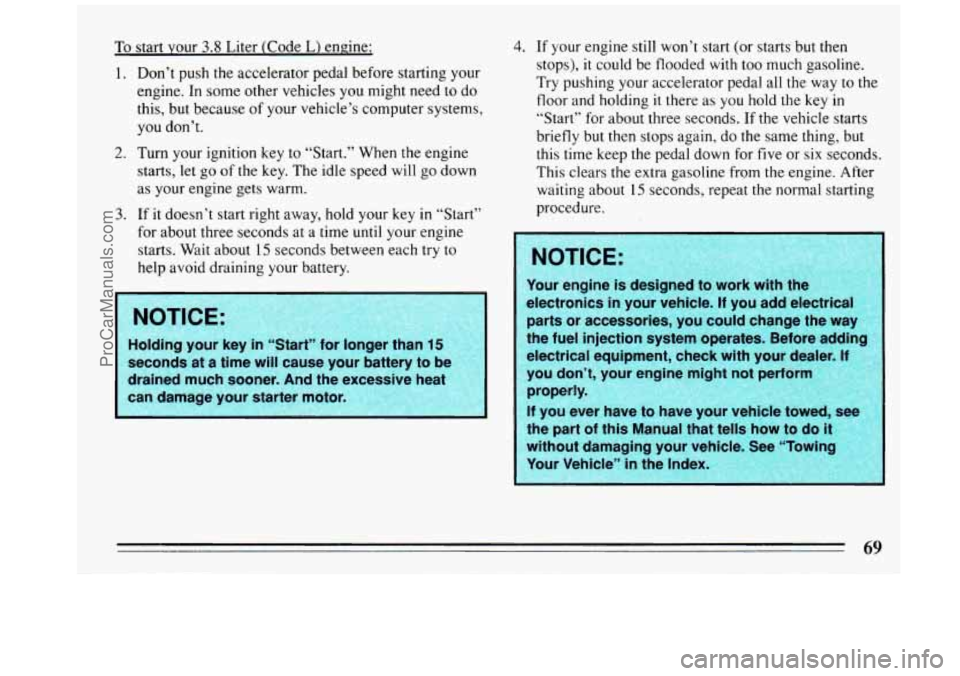
To start your 3.8 Liter (Code L) engine:
1. Don’t push the accelerator pedal before starting your
engine. In some other vehicles you might need
to do
this, but because of your vehicle’s computer systems,
you don’t.
2. Turn your ignition key to “Start.” When the engine
starts,
let go of the key, The idle speed will go down
as your engine gets warm.
3. If it doesn’t start right away, hold your key in “Start”
for about three seconds at
a time until your engine
starts. Wait about
15 seconds between each try to
help avoid draining your battery.
Holding your key in “Start” for longer than 15
seconds at a time will cause your battery to be
drained much sooner.
And the excessive heat
can damage your starter motor.
4. If your engine still won’t start (or starts but then
stops), it could be flooded with too much gasoline.
Try pushing your accelerator pedal all the way to the
floor and holding
it there as you hold the key in
“Start” for about three seconds.
If the vehicle starts
briefly but then stops again,
do the same thing, but
this time keep the pedal down for five or six seconds.
This clears the extra gasoline from the engine. After
waiting about
15 seconds, repeat the normal starting
procedure.
electronics in your vehicle. If you add electric
parts or accessories, you could change
the way
the fuel injection system operates. Before adding
electrical equipment, check with your dealer
‘I.
you don’t, your engine might not perform
properly.
If you ever
h h hicle towea,
the part
of this Manual that tells how to do it
without damaging your vehicle. See “To
Your Vehicle” in the Index, :, ’ .
69
ProCarManuals.com
Page 72 of 308
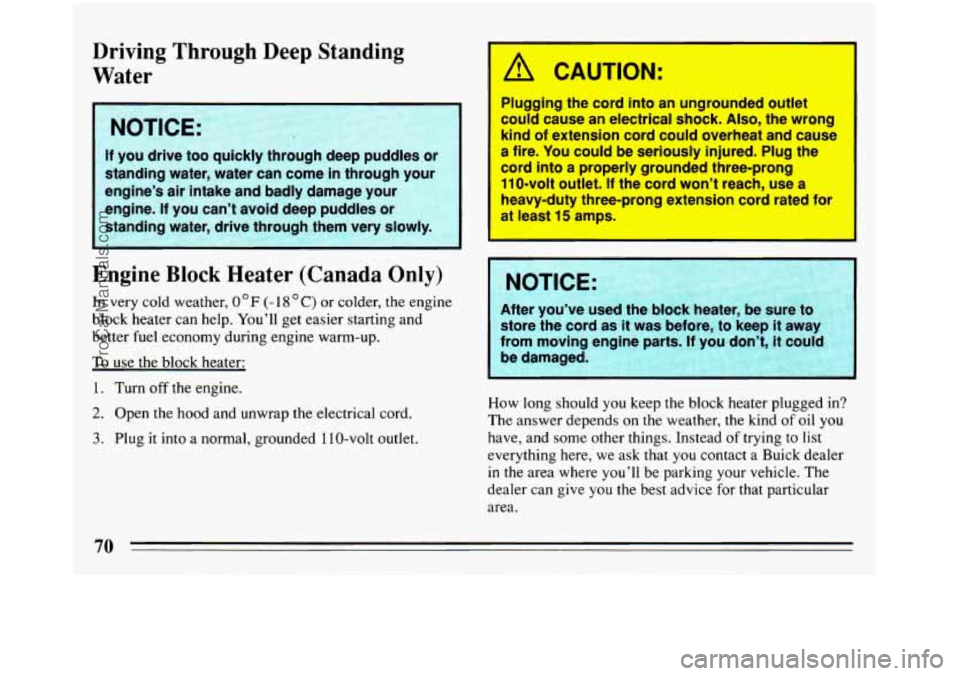
Driving Through Deep Standing
Water
If you drive too quickly through deep puddles or
standing water, water can come in through your
engine’s
air intake and badly damage your
engine. If you can’t avoid deep puddles or
standing water, drive through them very slowly.
Engine Block Heater (Canada Only)
In very cold weather, 0 F (- 18 C) or colder, the engine
block heater can help. You’ll get easier starting and
better
fuel economy during engine warm-up.
To use the block heater:
1. Turn off the engine.
2. Open the hood and unwrap the electrical cord.
3. Plug it into a normal, grounded 110-volt outlet.
I
Plugging the cord into an ungrounded outlet
could cause an electrical shock.
Also, the wrong
kind of extension cord could overheat and cause
a fire. You could be seriously injured. Plug the
cord into
a properly grounded three-prong
IlO-volt outlet.
If the cord won’t reach, use a
heavy-duty three-prong extension cord rated for
at least
15 amps.
I
I
x; NOTICE:
k After you’ve used the block heater, be sure to
:; store the cord as it was before, to keep it away
i from moving engine parts. If you don’t, it could
:: be damaged. .’, :.,* :>”!;.:,.”~ i” < .:-;:.&,a2% && ?3$?%7 -
How long should you keep the block heater plugged in?
The answer depends
on the weather, the kind of oil you
have, and some other things. Instead
of trying to list
everything here, we ask that you contact a Buick dealer
in the area where you’ll be parking your vehicle. The
dealer can give
you the best advice for that particular
area.
70
ProCarManuals.com
Page 73 of 308
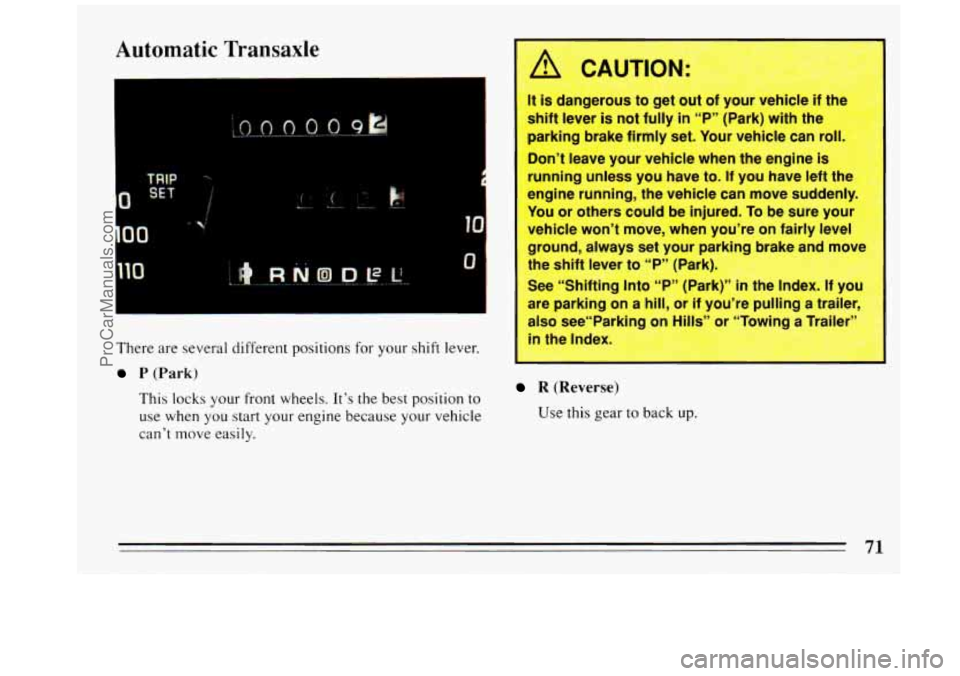
Automatic Transaxle
1
1%.
There are several different positions for your shift lever.
P (Park)
This locks your front wheels. It’s the best position to
use when you start your engine because your vehicle
can’t move easily.
A CAUTION:
It is dangerous to get out of your vehicle if the%
shift lever is not fully in “P” (Park) with the
parking brake firmly set. Your vehicle can roll.
Don’t leave your vehicle when the engine
is
running unless you have to. If you have left tht
engine running, the vehicle can move suddenly.
You or others could be injured. To be sure your
vehicle won’t move, when you’re on fairly level
ground, always set your parking brake and move
the shift lever to “P” (Park).
See “Shifting Into “P” (Park)”
in tl Index. I1 ;
are parking on a hill, or if you’re puliing a traller,
also see“Parking on Hills” or “Towing a Trailer”
R (Reverse)
Use this gear to back up.
71
ProCarManuals.com
Page 74 of 308
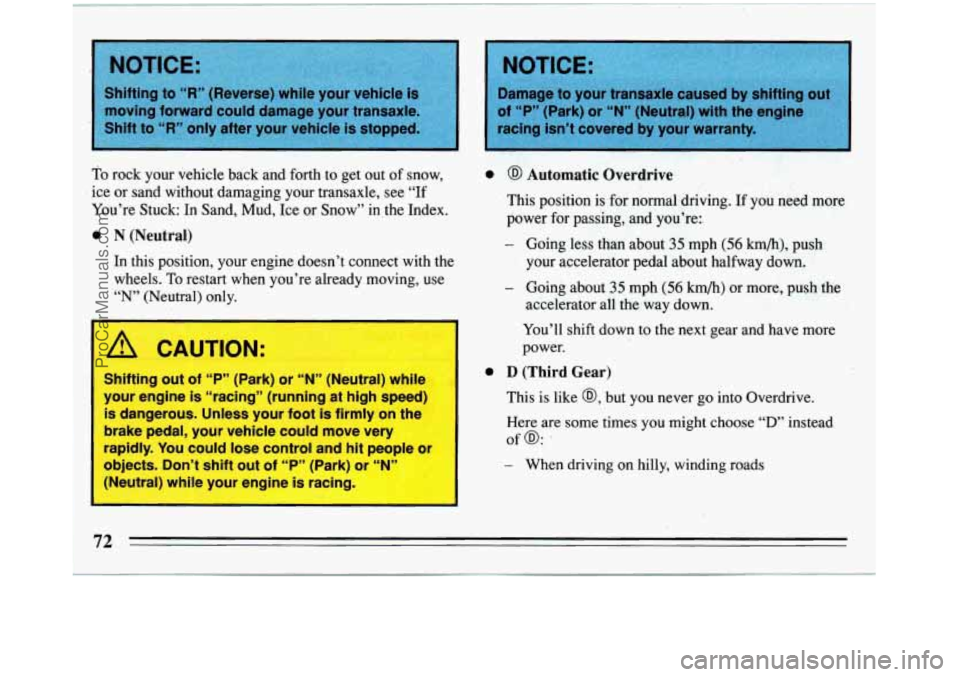
objects. Don’t shift out of ccPyy (Park) ----“N4 -- kutral) whil four engine i8 icing, I
NOTICE:
- When driving on hilly, winding roads
ProCarManuals.com
Page 75 of 308
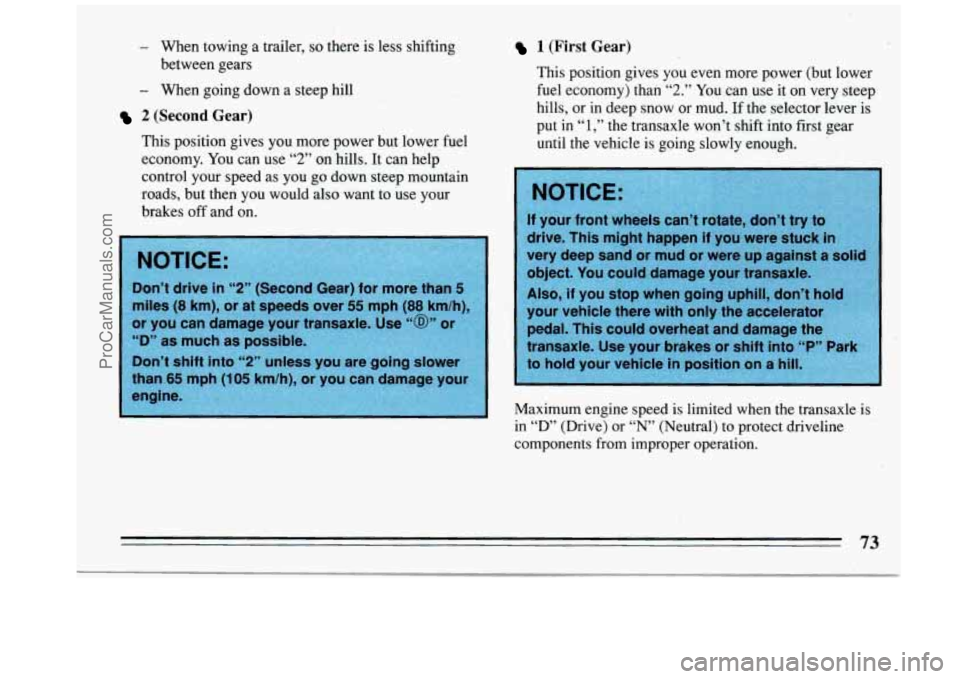
- When towing a trailer, so there.is less shifting
- When going down a steep hill between gears
’ 2 (Second Gear)
This position gives you more power but lower fuel
economy. You can use
2 on hills. It can help
control your speed as you go down steep mountain
roads, but then you would also want
to use your
brakes
off and on.
bb 97
miles (8 km), or at speeds over 55 mph (88 kmih),
or you can damage your transaxle. Use
‘@” or
“D” as much as possible.
Don’t shift into
“2” unless you are going slower
1 (First Gear)
This position gives you even,more power (but lower
fuel economy) than
“2.” You can use it on very steep
hills, or in deep snow
or mud. If the selector lever is
put’in
“1 ,” the transaxle won’t shift into first gear
until the vehicle
is going slowly enough.
Maximum engine speed
is limited when the transaxle is
in “D” (Drive) or
“N” (Neutral) to protect driveline
components from improper operation.
73
ProCarManuals.com
Page 76 of 308
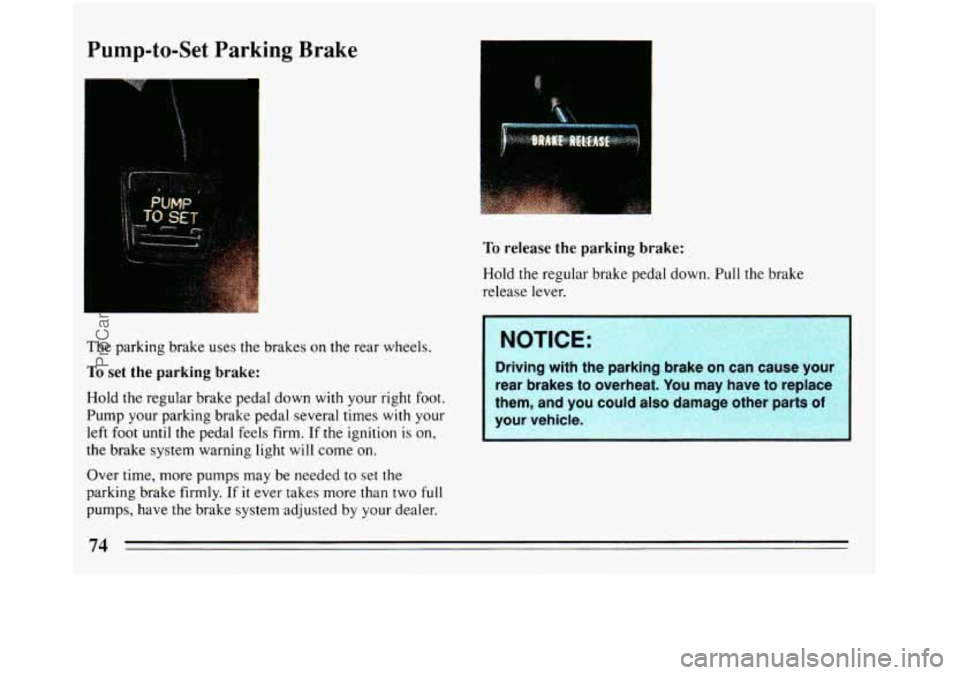
Pump-to-Set Parking Brake
The parking brake uses the brakes on the rear wheels.
To set the parking brake:
Hold the regular brake pedal down with your right foot.
Pump your parking brake pedal several times with your
left foot until the pedal feels firm. If the ignition is on,
the brake system warning light will come on.
Over time, more pumps may be needed to set the
parking brake firmly.
If it ever takes more than two full
pumps, have the brake system adjusted by your dealer.
To release the parking brake:
Hold the regular brake pedal down. Pull the brake
release lever.
.
NOTIC% I
Driving with the parking brake on can cause your
rear brakes to overheat. You may have to replace
your vehicle. them, and
you could also damage
74
ProCarManuals.com
Page 77 of 308
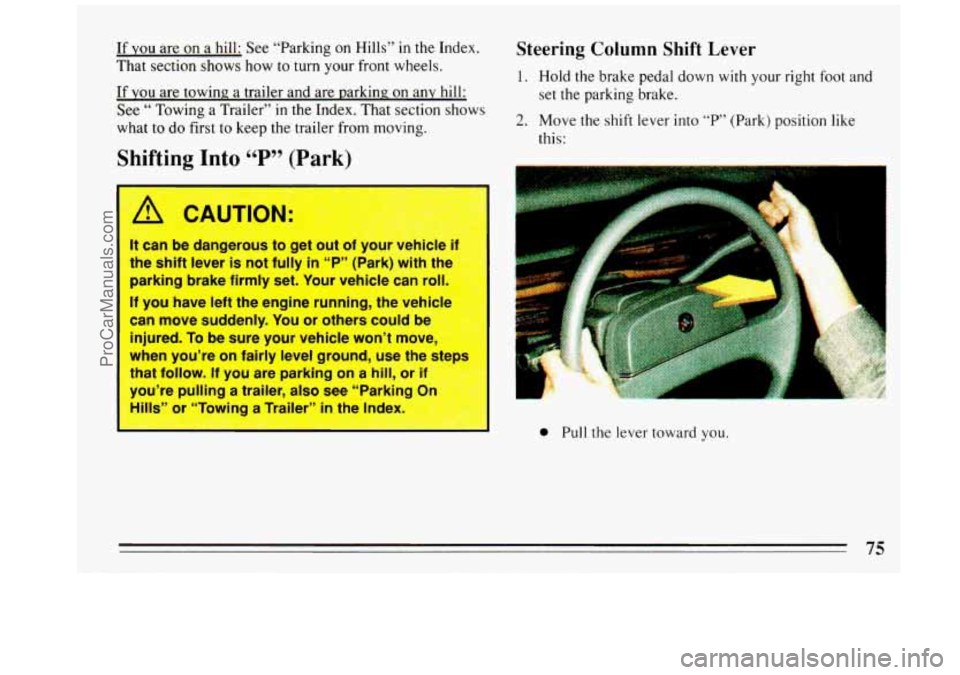
If YOU are on a hill: See “Parking on Hills” in the Index.
That section shows how to turn your front wheels.
If
you are towing. a trailer and are parking on any hill:
See
“ Towing a Trailer” in the Index. That section shows
what to do first to keep the trailer from moving.
Shifting Into 66 P 99 (P-k)
It can be dangerous to ger out of your vehicle if
the shift lever is not fully
in “P” (Park) with the
parking brake firmly set. Your vehicle can rol~
If you have left the engine running, the vehicl
can move suddenly. You or others could be
injured.
To be sure your vehicle won’t move,
when you’re on fairly level ground, use the
steps
that follow. If you are parking on a hill, or if
you’re pulling a trailer, also see “Parkinc 3n
Hills” 2r “Towing a Traile-” ’- the lrT’?x.
Steering Column Shift Lever
1. Hold the brake pedal down with your right foot and
set the parking brake.
2. Move the shift lever into “P77 (Park) position like
this:
0 Pull the lever toward you.
75
ProCarManuals.com
Page 78 of 308
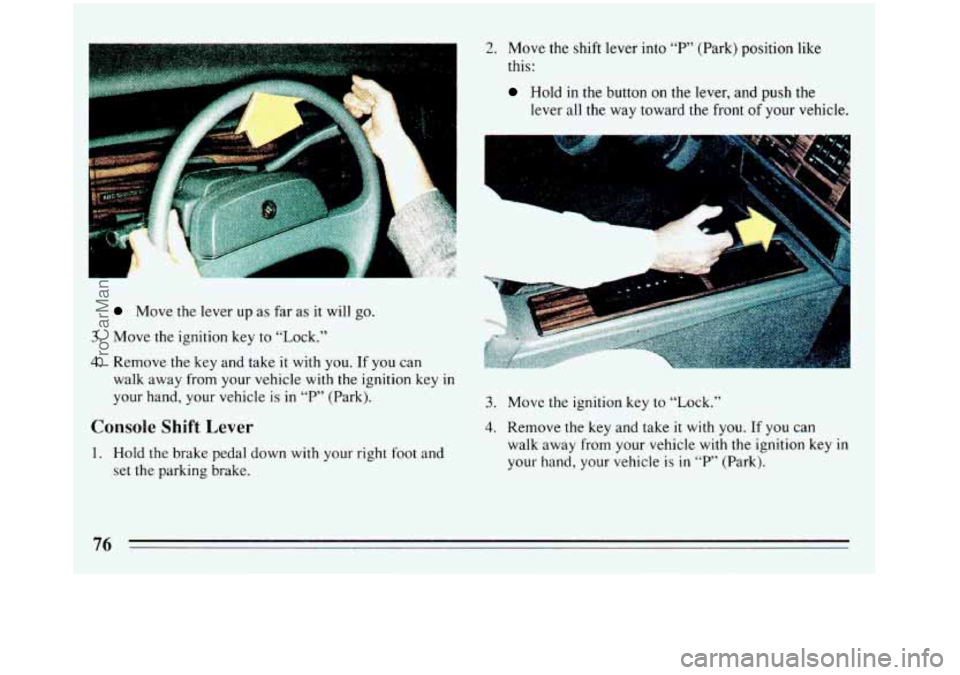
Move the lever up as far as it will go.
3. Move the ignition key to “Lock.”
4. Remove the key and take it with you. If you can
walk away from your vehicle with the ignition key in
your hand, your vehicle is in “P” (Park).
Console Shift Lever
1. Hold the brake pedal down with your right foot and
set the parking brake.
2. Move the shift lever into “P’ (Park) position like
this:
Hold in the button on the lever, and push the
lever all the way toward the front
of your vehicle.
-II
3. Move the ignition key to “Lock.”
4. Remove the key and take it with you. If you can
walk away from your vehicle with the ignition key
in
your hand, your vehicle is in “P’ (Park).
76
ProCarManuals.com
Page 79 of 308
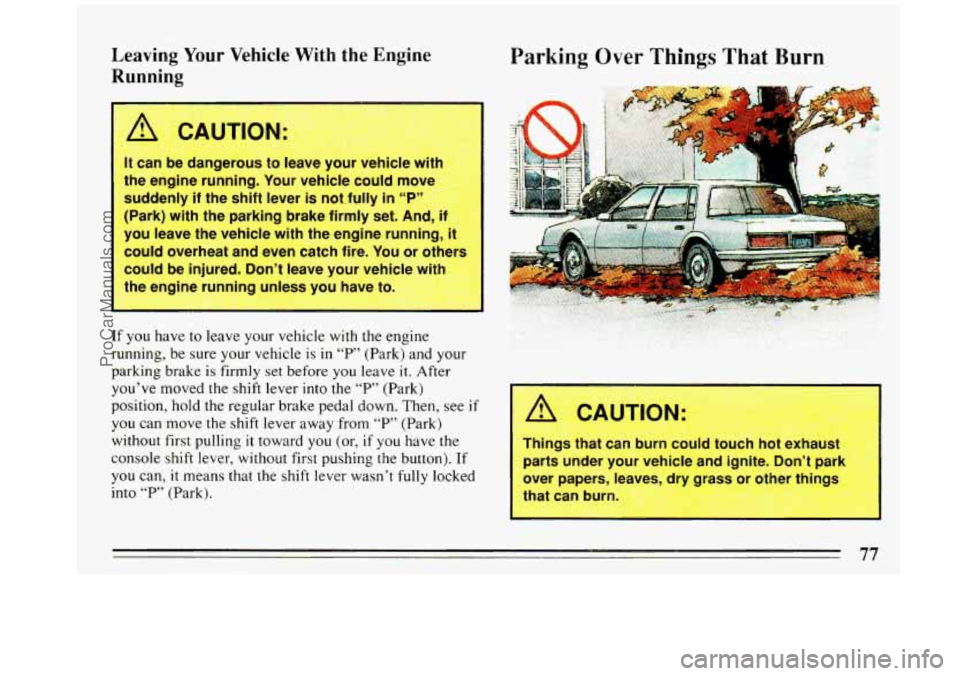
Leaving Your Vehicle With the Engine
Running Parking Over Tk 1gs That Burn.
I. ..
77
ProCarManuals.com
Page 80 of 308
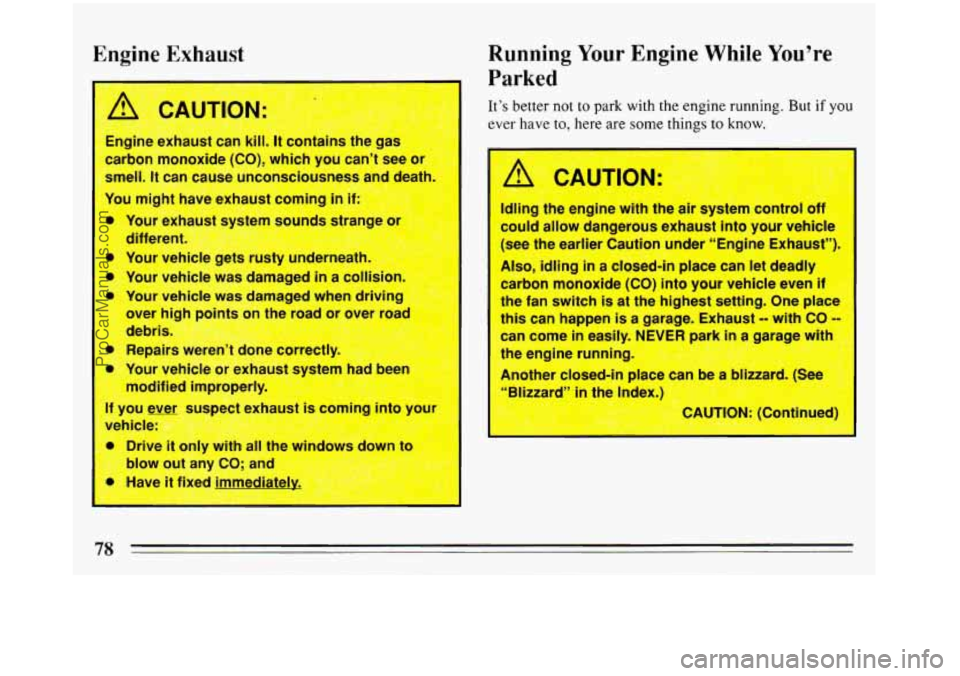
Engine Exhaust Running Your Engine While You're
1
Parked
It's
better not to park with the engine running. But if you
ever hr.72 to, he*- are some thir- to knn-{. A CAUTION:
Engine exhaust can kill. It contains the
carbon monoxide
(CO), which you can't jee
smell.
It can cause unconsciousnesf -nd deatl CAUTION. L
You might have exhaust coming in il Idling the engine with the air system control off
could allow dangerous exhaust into your vehicle
(see the earlier Caution under "Engine Exhaust").
I
Also, idling in a closed-in place can let deadly
carbon monoxide (CO) into your vehicle even
if
the fan switch is at the highest setting. One plac
this can happen is a garage. Exhaust
-- with CO
can come in easily. NEVER park in a garage with
the engine running.
Another closed-in pla De a Dwzara.
(see
"Blizzard" in the Index.)
CAUTION: (Continued)
I
I over hi!
debris.
0 Repairs weren't dl-..
Your vehicle or exha
aoints on
modified improperllf
If you ever suspect
t
-7hicle
Driv
h all tht ws >wn to
blow out any CO; and
Have
'- fixed immediatc
78
ProCarManuals.com